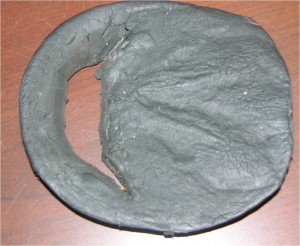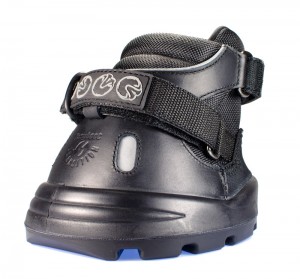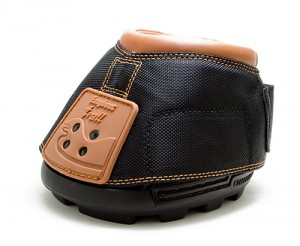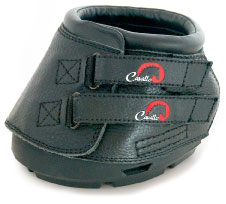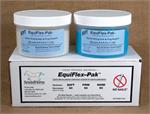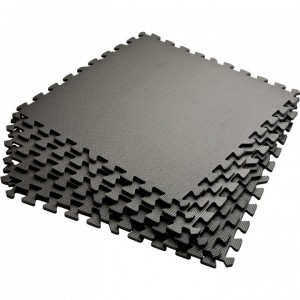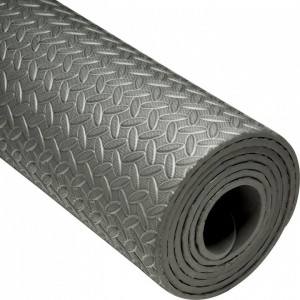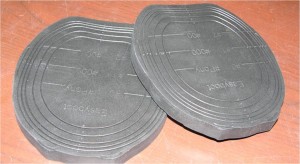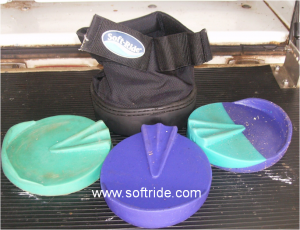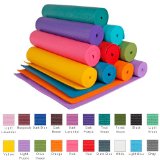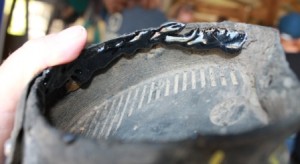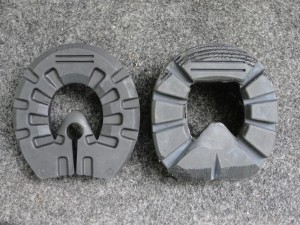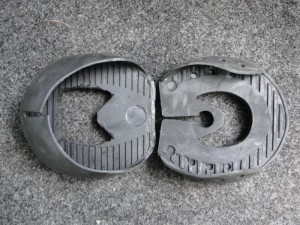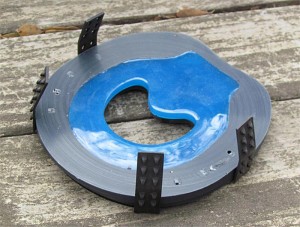My rule of thumb for protecting hooves for rehab is that the horse needs to move better with the protection than without it. Occasionally this means that we try a variety of pads, boots and glue-on shoes to see what makes the horse optimally comfortable.
Some horses like sole pressure, some horses are too sole sensitive for any padding. Some horses like frog pressure, some need frog relief. I’ve had horses that like pressure in one area of the sole and need pressure relief in another area.
A good example of this is for foundered horses, where we want to support the back of the hoof and frog, but want to remove pressure under the tip of P3. This is a relief pad used on a foundered horse:
Less is more, but occasionally we need more before we get to less .
I use a variety of different tools for protection… various boots, changed or checked daily, are my favorite option.
Glued on boots, simple casts or casts with Superfast soles, casts with glued on shoes and glued on synthetic or Epona shoes are some of the other options.
Another tool that can’t be discounted is the use of Hoof Armor http://www.hoofarmor.com/ to protect the sole and accelerate the accumulation of a thick, protective layer of sole.
PRIMARY CONSIDERATIONS?
Each “tool” has strengths and weaknesses, so the tool I choose depends on
- the individual horses feet
- the ability of the owner / barn to be supportive of that application
- the activity level of the horse
- the environment the horse lives in
TIME OFF OR REST?
Time off from work can be an important component of rehab unless the feet look ideal when the shoes come off. The horse may be moving much better barefoot or in boots than in shoes, and in that case, its easy to continue the level of work. Sometimes the horse will look better initially, then have a brief setback.
Shoe removal is simple if the hoof is healthy but can be a process if the back of the foot is weak.
How much time off is required? We all need to listen to our horses; if they feel good, they move in a free and open manner. If a horse has a healthy foot and some wall length beyond a fully developed sole, time off may be a few days. If there is pathology (thin soles, sore heels, inadequate wall at the ground), several weeks may be appropriate. The horse will tell you.
TEMPORARY REHAB ENVIRONMENT?
If a horse with pathology lives in an environment that is – because of the pathology – extremely uncomfortable for him, I suggest that the owner move the horse for a month or more to a facility with appropriate footing; this usually means no large gravel, minimal mud and accumulated manure.. An environment that is fantastic for a marginally sound horse can be very uncomfortable for a horse with significant hoof pain. Soft dirt footing under shade trees can be wonderful for a rehabbing hoof, and soft pasture is great if the horse isn’t IR. Many of our horse environments are fine for a sound horse but hard on a horse with pathological feet.
Boots & Barefoot
I prefer to be able to go with protection in the living environment with boots available as a backup. Most horses are okay barefoot if they are trimmed correctly…. timing shoe removal to be optimum and how the trim is done are both important factors! I insist that almost all clients have front boots on hand just in case the horse needs them.
If a horse has a good foot, barefoot is usually simple, If you’re reading this, you’ve probably encountered problems.
Horses feet heal fastest when the horse is comfortable, either barefoot or booted. If the horse is the least bit uncomfortable, its better to use boots and pads or a glue on shoe. I recently (4/2014) made the mistake of not encouraging boots, the horse seemed to walk well and the feet looked good, however the horse was having back problems and they related to foot discomfort. That horse is back in shoes, and I’m hoping the owner will allow me to try the Glue-on Easy Shoe Performance shoes on him.
When I’m considering boots, I have the client walk the horse in the areas the horse typically travels and watch the movement. If it looks good, I try the horse in boots and pads, and if the horse looks better in boots, we use boots.
The more comfortable the horse is, the faster their feet improve.
Boots 24×7
My favorite 24×7 boots are Easy Care Rx Boots, Easy Care Back Country Gloves with pads, Old Mac’s or Soft Rides. Easy Care Epics, Easy Care Gloves and Cavellos work for some horses. Boots should be removed for a few minutes daily. I use Gold Bond Powder in the boots and clean the feet using a wire or plastic scrub brush to gently remove any debris, loose frog and sole.
Pads
Depending on the case, I pad boots with a soft, cushy pad 1/8″ to 1/2″ deep. This is particularly important with founder or navicular. I personally prefer anti fatigue shop floor mats cut out to the shape of the horses hoof, but have used many of the Easy Care pads, sheepskin, yoga mats and the dental impression material that farriers use under pads in shoes.
Rubs
If the horse develops rubs, a strip of Duck Tape or Athletic Tape across the heels to protect the tender skin usually works. I do not put the tape tightly around the hoof, I put several overlapping strips from the side off the wall over the heel bulbs, just enough to protect them.
Hiking socks can be used over the hoof (with Gold Bond).
Glued On Boots & Shoes
Glue-on boots and shoes, done correctly, are a great way of providing 24×7 sole protection. I’ve glued on Glove and Renegade boots for rehab, both work very well. Holes can be cut in the sole of the Gloves to provide airflow (I use a door knob hole cutter on a drill), and debris may get up in the sole and cause a problem. It hasn’t created a problem for me but is a consideration; dental impression material can be used if needed.
With Glove Shells, I use a dremil to add small holes throughout the wall region to allow glue to seep out, adding to the adhesive space. I’ve also glued on several types of shoes, with a lot of Epona experience. The new Easy Shoe Performance (below) looks like it could be a favorite.
Easy Shoe:
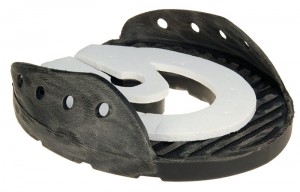
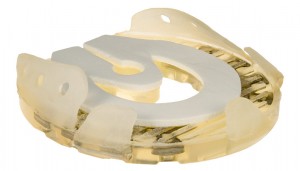
Glue-on shell and Easy Shoe comparisons:
Epona shoes:
Casting with a Shoe (aluminum or steel) to Preserve the Cast
When the horse lives in a dry concussive environment. I think that hard footings for horses are like hard footings for people… standing around on concrete all day for us is extremely hard on our bodies! If you put something soft on the foot – a rubber boot or even a cast on Epona, they relax visibly.
When the horse won’t be in hard work and is on soft footing, I feel metal shoes glued to a cast work fine. If the horse is on hard footing, I prefer a synthetic shoe or other non-concussive material.
Casting
When it comes to casting laminitic feet, its a real juggling act…. casting can be fantastic because it protects the sole and helps to stabilize the wall, BUT it constricts the wall, and if something happens that causes hoof expansion, like a laminitic event, the cast needs to come off fast.

